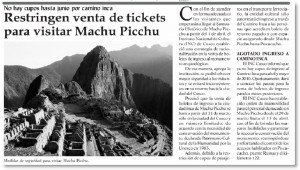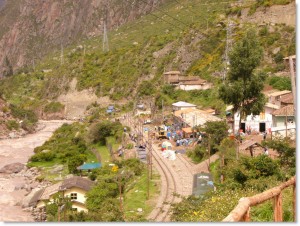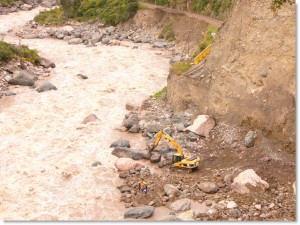Two months after torrential rain wiped out train access to Machu Picchu, Peru’s National Institute of Culture (INC) confirmed Monday it will ration the number of entrance tickets to Peru’s most popular tourist destination to ensure the Inca citadel isn’t inundated by visitors after the site reopens on April 1.
News that the INC planned to limit the number of Machu Picchu entrance tickets was first reported Saturday by the South American Explorers in an “Urgent Note” to its members, posted on its Cusco Clubhouse page.

“The sale of entrance tickets to the citadel of Machu Picchu will start March 31 only in the city of Cusco and in limited numbers, in accordance with the need for conservation of the monument, which was declared Cultural Patrimony of Humanity by UNESCO in 1983,” the INC told state-run news agency Andina.
The INC also said that it will only allow hikers onto the Inca Trail if they show they have a return ticket and confirmed seat on the train from Machu Picchu to Piscacucho. Entrance tickets onto the Inca Trail are already sold out for April and May, Diario del Cusco reported.

About 33 people, including tourists, government officials and travel agents, boarded a PeruRail train Monday for a test run on the rebuilt track, daily Peru.21 reported. They traveled between the Piscacucho train station at Km82, where the entrance to the Inca Trail is also located, and Aguas Calientes – the tourist town that sits in the ravine below Machu Picchu
On Friday, Juan Carlos Zevallos, the president of Peruvian transport regulator Ositran, announced after inspecting the train line that it is “in perfect condition to begin operations between Piscacucho and Aguas Calientes.”
Zevallos estimated that as of Thursday, April 1, the rail servcie would transport 1,500 tourists daily to Machu Picchu, and that that number would increase gradually to 2,500 as the rest of the rail line is repaired, El Diario del Cusco reported.
The floods and landslides that cut off train service to Machu Picchu in late January stranded hundreds of tourists in Aguas Calientes for days until they were airlifted out by helicopter. The disaster was taken by many as further proof that other routes in and out of Machu Picchu should be developed not only to provide emergency exits from the zone, but also to break the near-monopoly held by PeruRail and Aguas Calientes on access to the ruins and the tourism dollars that come with it.

But Machu Picchu’s remoteness is also a key element of how INC controls the number of visitors to the 15th century ruins.
The INC said Monday that personnel had been ordered not to leave their posts in the Machu Picchu Historical Sanctuary through April 15 to ensure smooth operations and also to restrict access into the site via alternative routes, including Santa Teresa — popularly known as the backpacker’s “back door” to Machu Picchu.
In 2007, Santa Teresa’s mayor took advantage of the fact that her impoverished town was accessible by road from the city of Cusco and the Sacred Valley by inaugurating the Carrilluchayac bridge. She built the bridge despite strident opposition from Peru’s central government and the INC’ because it allowed easy access via the Hydro-Electric Plant train station, west of Machu Picchu. From there it is a two- to three-hour trek along the the tracks to Puente Ruinas, where the switchback access road up to the citadel begins.
After the flooding in January, residents of Santa Teresa and neighboring towns and villages protested to pressure Cusco Regional Gov. Hugo Gonzales Sayán to send heavy machinery and workers to repair their damaged roads and bridges, and to establish their district as a formal gateway to Machu Picchu.
Gonzales and his regional director of economic development, Jean Paúl Benavente, pledged to make that wish a reality, but the INC and its sister agency, the Natural Resources and Environment Service (Sernanp), which have ultimate oversight of Machu Picchu, put the kibosh on their plan, saying, simply, it was under review.
Advocates for Machu Picchu’s conservation have long expressed fears that if the Santa Teresa route is opened wide, without strict regulation, it could swamp Machu Picchu with too many visitors. Peru’s government has worked hard to appease UNESCO’s demands for greater crowd control at Machu Picchu, and narrowly escaped being added to the list of endangered World Heritage sites in 2008 after the visitor numbers far surpassed the carrying capacity of the ruins.
The UNESCO-sponsored Management Plan for Machu Picchu called for no more than 917 visitors per day – and no more than 385 visitors at any one time – while the INC has recommended a maximum carrying capacity of 2,000 visitors. Peru’s central government advocated in 2002 for 3,400, and the parties settled in 2008 on a daily limit of 2,500 visitors.
The deal was struck after the Peruvian government proposed a $132.5 million emergency plan to preserve the ruins and limit the flow of tourists, as well as take measure to prevent forest fires and landslides. The plan included, among others things, the installation of several miles of optic fiber from Aguas Calientes to the citadel to set up surveillance cameras, the implementation of an entry ticket control program and the restoration of numerous monuments.





